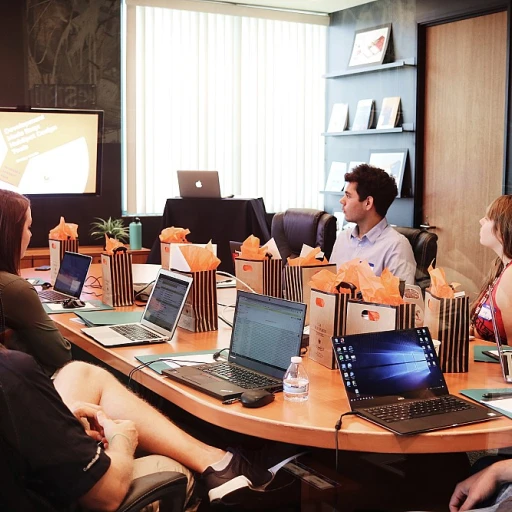Understanding the Strategic Vision
Comprehending the Overarching Business Blueprint
Engaging with senior leaders often begins with a profound understanding of the organization’s strategic vision. The questions you pose should delve into the company's long-term goals and initiatives. This insight is not merely for alignment but to guide your team’s efforts in a direction that supports organizational success. Knowing the strategic goals helps in effectively tasking employees and ensuring their efforts contribute meaningfully to the company's objectives. Developing an intimate knowledge of the strategy the senior leadership promotes can empower you as an office manager to facilitate employee engagement and career growth within your team. Understanding the company culture and strategy will help refine your decision-making processes when managing resources or guiding projects. Asking strategic questions about future directions, such as digital transformation, not only signals your commitment to the company's path but also enhances your team's readiness for changes. For those working in culturally diverse environments, understanding cultural nuances in strategic planning can further enhance your effectiveness within the organization. Consider exploring how you can bridge the gap to overcome cultural barriers for enhanced team dynamics (https://www.magicoffice.ae/blog/bridging-the-gap-can-office-managers-overcome-cultural-barriers-for-enhanced-team-dynamics), which can foster a workplace atmosphere where collaborative efforts align with strategic ambitions. In summary, understanding the strategic vision set by senior leaders equips office managers with the foresight needed to not only align team functions with business objectives but also position themselves as valuable contributors to the company’s success.Navigating Cultural Nuances
Decoding Corporate Traditions and Practices
Engaging with senior leaders in the Arabian Emirate company requires a nuanced understanding of the corporate environment. The organization operates within a unique company culture that reflects its regional heritage and global aspirations. To effectively communicate with upper management, acknowledging and respecting these cultural intricacies is essential.
Senior leaders often appreciate when employees take the time to ask thoughtful questions that reflect an understanding of both business priorities and cultural context. Such questions can illuminate facets of decision-making processes, revealing how the organization harmonizes its operational strategies with traditional and modern influences.
- What cultural factors influence the company's decision-making?
- How does the leadership integrate local customs with global business strategies?
Incorporating inquiries about how daily operations align with broader cultural norms and values can foster more meaningful dialogues with company leaders. This approach shows a genuine interest in the broader impacts of business initiatives and the role that cultural understanding plays in shaping the company's strategic goals.
Enhancing Operational Efficiency
Improving Workplace Operations for Better Outcomes
Engaging with upper management requires a keen understanding of how operations align with the overarching business strategy. This ensures that queries aimed at improving operational efficiency resonate well with senior leaders. Here are some strategic questions to consider:- How do our current operational processes support the business goals set by senior leadership?
- Are there any new technologies or methodologies we can implement to streamline our workflows and enhance productivity?
- What key performance indicators should we focus on to measure operational success?
Building Stronger Relationships
Fostering Meaningful Connections
Building stronger relationships with senior leaders is crucial for any office manager aiming to drive the organization toward success. Establishing a rapport with upper management not only helps in aligning with the strategic vision but also enhances employee engagement and career growth opportunities.
Here are some key strategies to consider:
- Understand Their Goals: Knowing the long-term goals of senior leaders and the company can help tailor your interactions and questions to support these objectives. This understanding can also guide your decision-making processes and strategic planning efforts.
- Ask Strategic Questions: Engage with leaders by asking questions that reflect an understanding of the company's strategic direction. Questions about the organization's digital transformation, new products, or services can demonstrate your proactive approach.
- Regular Communication: Maintain open lines of communication with senior leaders. Regular updates and feedback sessions can help you stay aligned with their expectations and adapt to any changes in strategy.
- Showcase Your Team's Success: Highlighting the achievements of your team members can strengthen your position and demonstrate your leadership capabilities. Recognizing employee accomplishments can also enhance overall team morale.
- Be a Problem Solver: Addressing challenges and opportunities with a solution-oriented mindset can help build trust and credibility with senior leaders. Demonstrating your ability to tackle issues effectively will help you gain their confidence.
By focusing on these strategies, you can cultivate stronger relationships with senior leaders, ultimately contributing to the organization's success and your own career advancement.
Addressing Challenges and Opportunities
Identifying Challenges and Opportunities in the Business Landscape
Engaging with senior leaders in your company involves more than just understanding the strategic vision or navigating cultural nuances. It requires a keen eye for identifying challenges and opportunities that can impact the organization’s success. This proactive approach not only demonstrates your commitment to the company's long-term goals but also positions you as a valuable asset in strategic planning.
To effectively address challenges and opportunities, consider the following strategies:
- Ask Strategic Questions: Engage with senior leaders by asking questions that delve into the strategic direction of the company. Inquire about the potential impacts of digital transformation or changes in the business environment. This will help you understand the broader context in which the company operates and align your efforts with the organization’s goals.
- Understand Company Culture: A deep understanding of the company culture will help you anticipate challenges related to employee engagement and team dynamics. By fostering a culture that encourages open communication and collaboration, you can help the organization navigate potential obstacles more effectively.
- Analyze Employee Feedback: Regularly review feedback from team members to identify recurring themes or concerns. This will provide insights into areas that may require attention or improvement, helping you address issues before they escalate.
- Collaborate with Team Members: Work closely with your team to identify opportunities for career growth and development. By supporting employee career paths, you contribute to a motivated workforce that is better equipped to tackle challenges and seize opportunities.
By focusing on these areas, you can play a pivotal role in guiding the company towards its strategic goals, while also enhancing your own career trajectory. Remember, the ability to effectively address challenges and capitalize on opportunities is a hallmark of successful leadership.
Feedback and Performance Evaluation
Assessing the Route to Effective Feedback
Engaging with senior leaders requires a comprehensive understanding of how feedback can be harnessed to drive employee engagement and business success. It's important for company leaders and employees alike to ask pertinent questions that foster an environment of trust and growth.- Strategic Feedback Questions: Initiating discussions with senior leaders often involves strategic and well-thought-out questions. These inquiries should aim to understand the long-term vision of the organization and how decisions align with this strategy. This not only highlights an employee's commitment to the company's goals but also reinforces their role in achieving them.
- The Role of Company Culture in Feedback: Feedback should be a two-way street, deeply integrated into the company culture. Questions that help evaluate how well employees can communicate concerns or suggestions are crucial. Leaders must be open to addressing these inquiries to nurture a motivated and cohesive team.
- Aligning Feedback with Career Growth: Addressing feedback through the lens of career development is critical. Employees should feel encouraged to ask about potential career growth opportunities and how their current role aligns with the strategic goals of the organization.
- Feedback Tools and Processes: Tools that facilitate feedback processes, such as digital transformation initiatives, can dramatically improve the efficiency and effectiveness of this practice. Knowing which tools or processes the company utilizes can assist employees in navigating these channels effectively, ensuring that they contribute to the company's overarching strategy efficiently.












